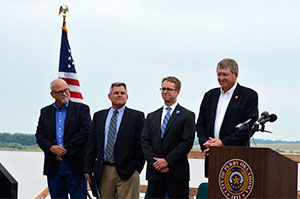Aging Oklahoma Dam Infrastructure Slated for Upgrades
PERRY, Oklahoma, July 18, 2014 – Communities across Oklahoma will benefit from a $26 million investment to upgrade dams that provide critical infrastructure and protect public health and safety.

National, state, and local officials gathered at Perry Lake to announce mostly 2014 Farm Bill funding for dam upgrades in a state that first partnered with USDA to build a watershed structure in the 1940s.
“This investment will protect people and ensure that these critical structures continue to provide benefits for future generations,” said Jason Weller, USDA Natural Resources Conservation Service Chief. “Homes, businesses, and agriculture are depending on responsible management of the dams and overall watersheds, and NRCS, Oklahoma Conservation Commission, and conservation districts are continuing to provide that support to these communities.”
More than 150 dams in 26 states will receive upgrade assistance for planning, design or construction—36 of which are in Oklahoma. The projects were identified based on potential risks to life and property if a dam failure were to occur. The number of these high-hazard dams in Oklahoma is on the rise due to residential development downstream of the structures. Only 30 of Oklahoma’s 2,107 watershed program dams were originally constructed as high-hazard. Today, 249 are classified as such.

Upper Black Bear Creek Watershed Dam No. 62 in Noble County where the funding announcement was made is one such structure. In addition to the benefits of municipal water and recreation to the City of Perry, the dam provides flood protection to 541 people who live and work downstream. Additionally, the dam protects seven county roads, one state highway, two U.S. highways, and Interstate 35. Together, these roads support 16,200 vehicles daily.
“Upgrading and extending the life of these structures is vital to Oklahoma’s economy. When the benefits of flood control dams are compared to the costs of maintaining them, it’s clear this is a quality investment that benefits all Oklahomans,” said Mike Thralls, OCC executive director.
Oklahoma’s conservation partners operate and maintain 2,107 watershed flood control dams across the state, representing a $2 billion public infrastructure that provides $82 million in annual benefits in the form of flood control, municipal water supply, recreation, wildlife habitat, and wildfire suppression.
For more information, visit the NRCS Watershed Rehabilitation webpage or contact your local conservation district.
